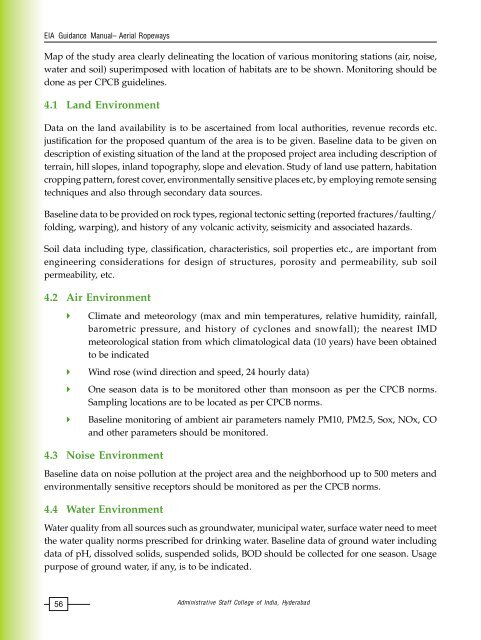Aerial Ropeways - Environmental Clearance
Aerial Ropeways - Environmental Clearance
Aerial Ropeways - Environmental Clearance
You also want an ePaper? Increase the reach of your titles
YUMPU automatically turns print PDFs into web optimized ePapers that Google loves.
EIA Guidance Manual– <strong>Aerial</strong> <strong>Ropeways</strong>Map of the study area clearly delineating the location of various monitoring stations (air, noise,water and soil) superimposed with location of habitats are to be shown. Monitoring should bedone as per CPCB guidelines.4.1 Land EnvironmentData on the land availability is to be ascertained from local authorities, revenue records etc.justification for the proposed quantum of the area is to be given. Baseline data to be given ondescription of existing situation of the land at the proposed project area including description ofterrain, hill slopes, inland topography, slope and elevation. Study of land use pattern, habitationcropping pattern, forest cover, environmentally sensitive places etc, by employing remote sensingtechniques and also through secondary data sources.Baseline data to be provided on rock types, regional tectonic setting (reported fractures/faulting/folding, warping), and history of any volcanic activity, seismicity and associated hazards.Soil data including type, classification, characteristics, soil properties etc., are important fromengineering considerations for design of structures, porosity and permeability, sub soilpermeability, etc.4.2 Air EnvironmentClimate and meteorology (max and min temperatures, relative humidity, rainfall,barometric pressure, and history of cyclones and snowfall); the nearest IMDmeteorological station from which climatological data (10 years) have been obtainedto be indicatedWind rose (wind direction and speed, 24 hourly data)One season data is to be monitored other than monsoon as per the CPCB norms.Sampling locations are to be located as per CPCB norms.Baseline monitoring of ambient air parameters namely PM10, PM2.5, Sox, NOx, COand other parameters should be monitored.4.3 Noise EnvironmentBaseline data on noise pollution at the project area and the neighborhood up to 500 meters andenvironmentally sensitive receptors should be monitored as per the CPCB norms.4.4 Water EnvironmentWater quality from all sources such as groundwater, municipal water, surface water need to meetthe water quality norms prescribed for drinking water. Baseline data of ground water includingdata of pH, dissolved solids, suspended solids, BOD should be collected for one season. Usagepurpose of ground water, if any, is to be indicated.56Administrative Staff College of India, Hyderabad
















